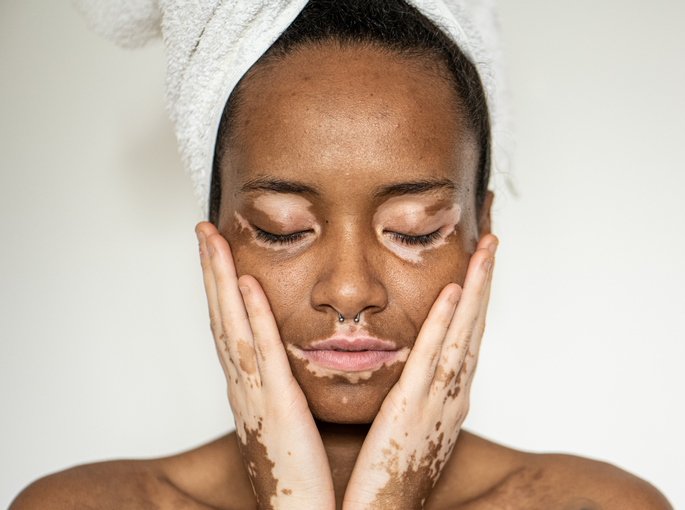Vitiligo: Understanding Vitiligo In The Black Community
What Is Vitiligo? : Understanding Vitiligo In The Black Community

Source: Alvarog1970 / Getty
Michael Jackson claimed to suffer from vitiligo, although many skeptics accused the famous singer of skin bleaching. Canadian model Winnie Harlow rose to prominence in the fashion world due to her unique look caused by the common skin condition, but what is vitiligo exactly?
According to the American Association of Dermatologists, vitiligo is a disease that causes areas of the skin to lose color, resulting in spots and patches of lighter skin. Some individuals impacted by the condition develop a few spots. Others suffer from more widespread color loss.
There are two types of vitiligo. The most common type is non-segmental vitiligo, which tends to develop slowly. New patches of vitiligo can develop off and on throughout a person’s life. Segmental vitiligo is another common form of the skin condition. AAD notes that people who have this type tend “to see a rapid color loss on one side of the body. After 6 to 12 months, segmental vitiligo tends to stabilize, meaning that the color loss stops. Once it stops, most people with segmental vitiligo don’t develop new patches or spots.”
Some health experts refer to the condition as an autoimmune skin disease. Vitiligo occurs when the body’s immune system attacks an individual’s pigment cells or melanocytes. This causes large white patches and discoloration to appear on the skin. The unique disease often appears around the eyes, face, and hands, but it could also develop in more sensitive areas of the body like the mouth, scalp, and groin region.
Luckily, vitiligo is not contagious or life-threatening.

Source: Andrea Migliarini / Getty
How does Vitiligo impact Black people?
It’s still unclear as to what causes the body’s immune system to destroy melanocytes in people with vitiligo. MedicinePlus.Gov notes that the condition is relatively common, affecting between 0.5 to 1% of the worldwide population. Vitiligo can occur in people of all races, but the disease may be more visible in individuals with darker skin.
According to statistics, 50 percent of individuals affected by vitiligo start to form skin discoloration before they turn 20. Health experts believe that hormone changes or “stressful” events like childbirth can trigger the condition. It can also be passed down genetically if you have a family history of vitiligo. While any race can be affected, studies suggest that prevalence can vary depending on a person’s location. A 2016 study published by Plus One found that there was a relatively high prevalence of vitiligo in African women. Researchers cautioned that the study did not provide enough evidence to suggest that the condition was more prominent among African people. In fact, in a 2020 study conducted with 1,487 participants, 46.6 percent of patients were white.
Social stigmas
Living with vitiligo can be difficult for some individuals due to vicious social stigmas. Black author and reporter Lee Thomas spoke about the challenges of coping with vitiligo in his book Turning White: A Memoir of Change. In the early onset of his condition, Lee confessed that walking outside was “traumatic” at times due to people staring at the discoloration on his skin.
“That’s the truth, and, you know, I was a doubter of Michael Jackson before this happened to me, but I understand the one glove,” he told NPR in 2007. “I mean, how are you going to cover that up when you have big white patches on your hands, and on your face for that matter? Could you imagine being the most famous person on the planet?”
Lee continued, “Everybody thinks you look like the cover of “Thriller,” and yet you look like the cover of my book, which is a blotchy face of white and black, and you have to reveal that to millions of people? I mean, I scared a little girl once, and it was really traumatic for me because she really screamed. She was about three. And I stayed in the house for two weeks.”
Rising model and activist Iomikoe Johnson said she felt suicidal when she was first diagnosed with the condition at the age of 25. Her sadness was stoked by mean comments she would receive from community members in her hometown of Texas.
“At the start, I was scared about changing color. I have been a dark skin lady my whole life and then suddenly my skin became white. It was scary,” she told the Daily Mail back in February 2022. “There is nothing wrong with being white but that isn’t who I am. Every day, I am accused online of bleaching my skin and called names such as cow or Dalmatian.”
Now, at the age of 42, Johnson has built a thick layer of skin against the hurtful insults, but sometimes, it hurts to see her own community voicing some of the nasty comments.
“The black community haven’t really accepted me as they think I am bleaching my skin,” she added. “It hurts so bad when a comment comes from someone from my community – as a black person, they should know how it feels to be discriminated against.”
Social beliefs can negatively impact the quality of life for patients living with vitiligo, especially women. An article published by The Conversation found that in Nigeria, some patients experienced “discrimination from their immediate family members, employers, and the community at large.” Religious beliefs can compound those stigmas. For example, in some areas of the country, people believe that vitiligo is “God’s punishment” for their sins.

Source: rparobe / Getty
Can it be treated?
Currently, there is no cure for vitiligo, but special treatments may help to slow down pigment loss for those affected. Some dermatologists have been known to prescribe corticosteroids in people with early stages of vitiligo. The medication can be applied to the skin, but only for a short period. Medical experts recommend that patients use corticosteroids short term due to possible side effects, according to AAD.
Some vitiligo patients are using light therapy to help restore pigmentation to their skin. With this treatment, affected areas of the skin are exposed to a special ultraviolet light that can help to restore a person’s natural skin color. If the area is large, a dermatologist may recommend a procedure called phototherapy.
During phototherapy, patients expose their skin to UV light for a specific amount of time which must be determined by a dermatologist. Individuals are required to stand in a lightbox, allowing their entire body to be exposed to the unique UV light.
In more extreme cases, some patients may opt to undergo surgery to help restore skin color. A skin graft or cell transplant can be used to slow down the discoloration process.
SEE ALSO:


















